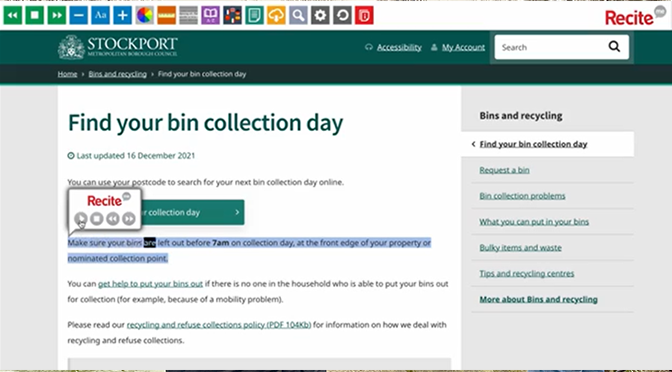Today is Global Accessibility Awareness Day, a day dedicated to thinking about digital access and inclusion. The internet has become an essential part of our daily lives, however, many people miss out on the opportunities it offers because of barriers to getting online.
In Stockport, we’re committed to breaking down these barriers. Our DigiKnow alliance supports anyone who needs help getting online or with digital skills. We’ve also added an accessibility toolbar to our Stockport Council website to support those with disabilities. Recite Me, which developed the toolbar, is an expert in website accessibility, and we are delighted to have them as a partner in DigiKnow.
In this extract from his blog, Michael Halpin, Head of Marketing, discusses why website accessibility matters and what you need to know. You can read the full blog on Recite Me’s website.
Did you know that around 1.3 billion people worldwide have a disability that means they’re unable to access or use the information on your website if it’s not designed with accessibility in mind?
In today’s digital age, the internet has become an integral part of our daily lives and culture. So much so that the average internet user now spends a staggering 400 minutes – nearly seven hours – online every day. From banking, shopping, and booking holidays to accessing learning resources, entertainment, and communication forums, online platforms make light work of tasks and activities that once involved physical trips to brick-and-mortar locations.
However, unless websites are accessible, that’s not so true for individuals with disabilities.
What is an Accessible Website?
An accessible website is one with content and functionality that is fully available to as many people as possible.
Traditionally, people tend to think of website accessibility in the same way they’d think about accessibility considerations in the non-digital world. In other words, in terms of features that make businesses accessible for those with physical disabilities. But there’s a bit more to it than that.
Of course, the needs of internet users with physical and motor disabilities must be considered. However, there’s also a significant percentage of internet users with hidden disabilities like decreased vision, literacy problems, neurological and cognitive disorders, and linguistic differences. An accessible website makes online content navigable and understandable for individuals across all of these groups.
Why do we need to have accessible websites?
It’s the right thing to do – People with disabilities make up the largest minority group in the world, and disabled individuals have just as much right to access online information, products, and resources as anyone else.
It’s the smart thing to do – People with disabilities control $8 trillion in annual spending. Businesses with an accessible website broaden their audience by making their products and services available to their spending power.
It’s a thing you must do – Having an inclusive website is required by law in many countries. Failure to comply or meet minimum accessibility standards can result in lawsuits, fines, and reputational damage.
Common Website Accessibility Barriers
Accessibility barriers refer to obstacles that prevent individuals with disabilities from accessing, navigating or engaging with content on a website. The type of barriers encountered can differ between people depending on their own personal circumstances. However, there are a few that stand out as being the most common, these include:
Colour Contrast – When the contrast between text and background colours is insufficient, the content becomes harder to perceive and read.
Missing ALT text – People who rely on the use of screen readers to understand web page content require alt text for images. If there is no alt text added, then the user will be unaware of the image and the context it provides to the written text.
Non-descriptive link text – When text links are not adequately described or labeled, users who rely on screen readers or keyboard navigation encounter difficulties.
Web Accessibility Laws and Legislation
Every country has its own set of website accessibility laws. Typically, all digital products with accessibility stipulations fall under the remit of pre-existing disability and equality legislation. A few examples include:
- The Equality Act (UK)
- The European Union Directive (EU)
- The Americans with Disabilities Act (USA)
- Accessible Canada Act (Can)
- Disability Discrimination Act (AUS)
Failure to comply or meet minimum accessibility standards on your site can result in lawsuits, fines, and damage to a business’s reputation.
You can’t improve if you don’t know what you’re doing wrong. You’ll need to check the legislation that applies to your organisation and familiarise yourself with the Web Content Accessibility Guidelines (WCAG). WCAG 2.1 Level AA is typically the minimum reference point for organisations looking to make their digital platforms accessible. Plus, making adjustments with WCAG 2.1 means you’ll automatically check the criteria required for national legal compliance.
Update Your Website Design
There are several design and development considerations involved in building an inclusive website. The basic ‘must have’ features needed to ensure inclusive online journeys for everyone include:
- An inclusion-focused content management system.
- Properly structured content.
- Alternative text on images.
- Descriptive names on links.
- Captions and transcripts for audio and video content.
- Sufficient colour contrast
- Clear and consistent navigation – including keyboard-only navigation.
- Accessible forms and downloads.
- Responsiveness across a range of devices (mobile, tablet, PC).
For more information, tips, and actionable processes to work through, download our free Online Accessibility and Inclusion Toolkit.
Sign up for email alerts for regular updates from the #DigitalStockport blog.

